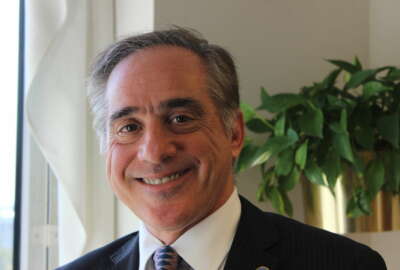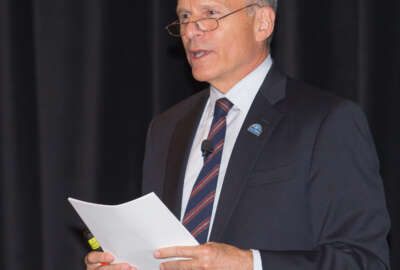

While new laws and programs have focused on patients, employee morale remains low at the Veterans Health Administration. As long as that remains the case, patie...
Dr. David Shulkin’s first leadership meeting at the Veterans Health Administration did not go well.
About two dozen leaders — the head of medicine, the head of nursing, the chief financial officer and others among the department’s most powerful officials — sat quietly on that July day. Shulkin had just been sworn in as the under secretary of health at the VA. They were worried about the new boss, he surmised in an exclusive interview with Federal News Radio.
So, similar to the first day of camp, he resorted to group exercises to break the ice. He asked them to introduce themselves and talk about their colleagues. He tried to soothe their concerns by saying he did not want, or expect, them to agreed with him all the time.
“If you have an environment where people are afraid to speak their mind or talk about concerns, you develop problems in the organization,” he said. “VA had a history of that, where people were afraid to bring bad news forward.”
Once the leaders began to talk, “they described what it feels like to be in an organization that doesn’t feel good about itself,” he said. “There was a time that they had felt very, very proud about working here and now some of them felt somewhat embarrassed about where they worked.”

Therein lies Shulkin’s toughest challenge: getting VHA leaders and frontline employees alike to speak up in an organization that, in the past, has not looked kindly on dissent. While new laws and programs have focused on patients, employee morale remains in the dumps. As long as that remains the case, patients will not get the best from the VA’s health system, said Shulkin.
“When you have satisfied professionals and employees who work in your environment, they take good care of patients,” he said. “That’s always been a strategy that, I believe, is effective in health care.”
In the spring of 2014, Shulkin’s predecessor, Robert Petzel, resigned after news broke that the VA had delayed in scheduling critical patient appointments at facilities nationwide. Petzel, like many VA leaders, had spent decades at the department. Shulkin, a long-time hospital executive, had never served in the military or government. That was attractive to a White House under pressure to set a new direction. A mysterious headhunter invited Shulkin to lunch. Then the White House called.
“I basically said to them, ‘If what you’re looking for is somebody who understands the culture and the way you do things in the VA, I’m not your person. I’m sure there are many, many bright talented people within the system whom you could tap on the shoulder. If you’re looking for somebody who has worked in the private sector and can bring that experience to the VA and not be afraid of challenging the status quo, but challenge us to do better, I think I can be helpful,'” he said.
As a CEO at hospitals in New York and New Jersey, Shulkin has faced morale problems before, although none as large or public as those caused by the scandals at the VA. On his first day as CEO of Beth Israel in New York City, for example, he found an inflated rat in front of the hospital entrance. It was a warning from the labor union that represented employees.
“I quickly learned it’s not a good idea to touch the rats,” he said. “But I quickly worked with the union in a positive way, understanding that the best job security is patient satisfaction. If people don’t want to come to your system, you don’t need employees. So we began to align our interests and listen to each other.”
Shulkin is one of several new VA leaders who come from the private sector. Secretary Bob McDonald led Procter & Gamble. Deputy Secretary Sloan Gibson came from the United Services Organizations. The department’s first customer service chief, Tom Allin, was a successful restaurant executive. The new chief information officer, LaVerne Council, was a vice president at Johnson & Johnson and Dell, Inc.
Peter Levin served as VA’s chief technology officer before returning to the technology sector in 2013. He said he views the new leadership as a positive sign that the Obama administration is trying to infuse the department with new ideas.
But leading such a large bureaucracy comes with its own challenges, he said.
“People who come in from the outside think it’s a bigger version of what they’re used to,” he said.


The government has its own culture and rules. Rarely are civil servants fired, he said. Much more often, they outlast the political appointees. To gain their trust, Levin said he sought “quick wins,” relatively easy successes that would show employees that he meant business. He used his authority to prod the department to do the required software tests so that it could launch a suicide prevention chatline that it had already developed. Only then was he was able to move on to more ambitious initiatives like the Blue Button, which lets veterans download their own medical histories, he said.
Shulkin said he does not see any quick wins in the VA’s health care system.
“I wish there were quick wins,” he said. “But in health care and certainly in an organization like this, what you’re trying to do is build long, sustaining change and the most important thing to do is to invest in people.”
Dr. Katherine Mitchell, who exposed misconduct at the Phoenix VA medical center, said Shulkin deserved credit for tackling pressing issues, such as a backlog of unresolved urgent appointments. (VA physicians and clerical staff nationwide will review the cases in a “stand down” Saturday. Patients who need to be seen right away will get care immediately).
But employees’ morale will not improve until they feel safe to report wrongdoing, she said.
“Absolutely nothing has changed,” she said. “I continue to receive phone calls from actual or potential VA whistleblowers who are still afraid of retaliation.”
Germaine Clarno, a social worker who reported similar problems at Edward Hines Jr. VA Hospital in Chicago last year, said she attempted to bring up the problem to Shulkin when he visited. But she hasn’t heard anything from him since. She questioned whether executives from the private sector could understand the struggles that rank-and-file federal employees felt.
“How can they know what’s going on with frontline employees when they’ve never been there?” she asked.
Vacancies at high levels of the organization contribute to the problem — 43 percent of VA regional networks and a quarter of its medical centers lack directors. Acting directors have served 90-day stints at Hines ever since its last leader resigned in October 2014, Clarno said.
“No one knows who is the captain of the ship. Who do you go to when you have issues?” she said. “Three months isn’t a long time at the VA. When a new director comes in, you have to start from scratch.”
Both Clarno and Mitchell agreed with Shulkin’s premise that VA’s recovery depended on its employees.
“All of the whistleblowers risked their careers to report serious problems, experienced the worst in the VA as a result, and yet most still remain because the mission is so important. Generally, even the whistleblowers who left did so only because they were forced out, not because they chose to stop serving veterans. Tapping into that level of employee dedication would be invaluable to the VA,” said Mitchell.
Shulkin said he had heard employees’ complaints. Since taking office in July, he has traveled to VA facilities, sent out regular video messages and communicated with employees on an internal Facebook-like social media channel.
“They see a bureaucratic organization that prevents them from helping veterans,” he said. “They’re complaining about rules and regulations that prevent them from doing the right things.”
In response, he is trying to streamline reporting requirements and procedures that slow employees down. The many empty leadership spots remain his “single biggest concern,” he said.
But he said he hears both good and bad from employees about their managers. To him, that shows a need for greater consistency, best practices and standards across the system, something he intends to work on throughout the next year and a half.
Through all of this, he said, he is trying to show employees that he is paying attention to them and wants them to have the tools and resources that they need. But it is not his job to convince employees to speak up about the problems they see, he said.
“They have to see this themselves. They have to believe that it feels different to work in the organization than it did before,” he said. “In an organization as big as ours, with over 300,000 people, that doesn’t happen fast. It’s going to be earned one small victory at a time.”
But he sees signs of progress. McDonald has required his leaders to undergo 360-degree evaluations, in which direct reports provide feedback on their supervisors. Shulkin said he received a comment from a manager that stuck with him.
“‘I never thought I’d be at the point where we’d actually laugh again, but we are laughing and it means we’re having fun,'” he said.
“Taking care of veterans is probably one of the greatest honors that one can have but it’s a good thing to have fun at work and, especially in high-stress situations, to let steam off,” Shulkin said. “The fact that people are feeling a little better about their environment will let them do their job better.”
Copyright © 2024 Federal News Network. All rights reserved. This website is not intended for users located within the European Economic Area.
